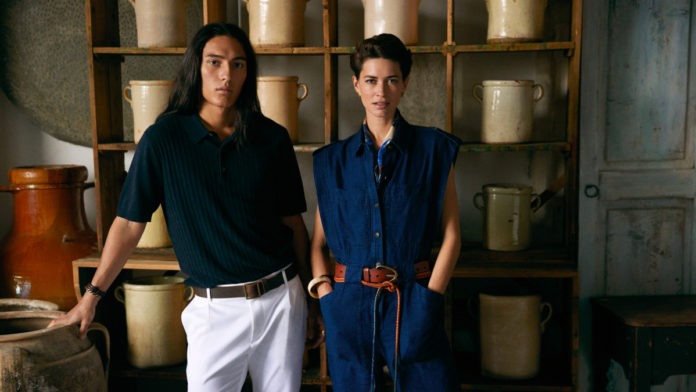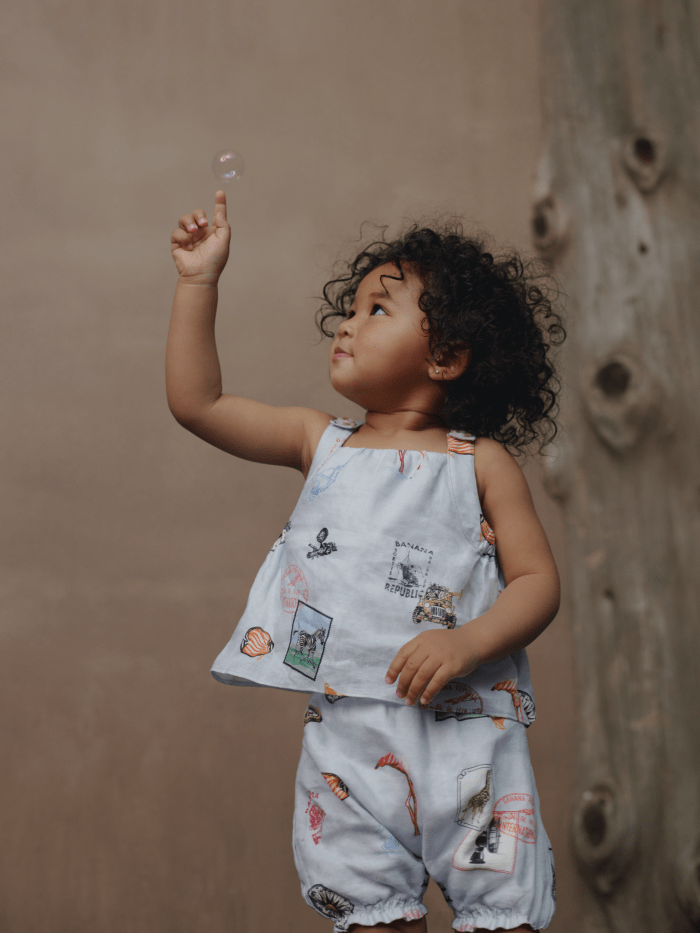Anneke Knot grew up with what she calls a “Banana Republic mom.” In the early- to mid-aughts, Knot says, there was no chicer retailer on Planet Earth — of that she was certain. This was in the age of business casual and Stacy London, where kitten-heeled sling-backs accessorized voluminous belts and aubergine blouses. And there was Banana Republic, at the heart of it all.
Eventually, it was Knot’s turn to buy adult clothes like the ones Banana Republic once made so well. But for the last decade, the retailer has gone the way of its fellow mall brands, struggling to sell clothing that appeals to today’s shoppers. This, as ever, spelled trouble: In the fourth quarter of 2020, parent company Gap Inc. reported a $16 million net loss, with Banana Republic’s same-store sales dropping 2% from 2019 levels. The pandemic didn’t help matters, but can’t be blamed entirely.
Then, one day last fall, Knot — now working as the assistant beauty editor for Real Simple and Health — was served a sponsored Instagram ad for a brand that purported to be Banana Republic, in that it bore the same typeface that previously adorned so many of the tags in her mom’s closet. And yet, it was otherwise unrecognizable, featuring clothes more fit for the Instagram age than reruns on TLC. Knot took to TikTok to alert the masses.
“The moral of the story is that Banana Republic has had a glow-up, and we need to stop sleeping on it,” she said, in a voiceover.
Knot was right: Banana Republic has had a glow-up, indeed. On March 14, 2021, the retailer teased its new era — where else? — on Instagram, posting a cryptic caption promising a “new adventure” alongside a graphic that simply stated, “The journey continues.” The retailer began rolling out an entirely new creative direction from there, complete with a new logo, new styling and, as of this spring, new categories. It even started working with the glossy, fashion-focused PR agency, PR Consulting.
“Imagined Worlds, our recently reinvented creative identity, is our springboard to redefine fashion, design, activism, sustainability and creativity,” president and CEO Sandra Stangl, who joined the brand from Restoration Hardware and Pottery Barn in December 2020, writes in an email. “Reflecting Banana Republic as it was originally conceived — a fictitious territory — we’re building on our heritage and reinventing it for today in the form of democratic, approachable and inclusive luxury.”
When Mel and Patricia Ziegler founded Banana Republic in 1978, it wasn’t to create the next great mall brand, but to offer specialty apparel for those leading adventurous lifestyles. Originally called “Banana Republic Travel & Safari Clothing Company,” the Zieglers launched the retailer while working for the San Francisco Chronicle, where they became known for the unique articles of clothing they brought home from their travels. Early fans of the brand may remember its hand-drawn catalogs, which printed fictional explorer stories alongside product. Gap Inc. purchased the company in 1983, changing its name and, later, its DNA.
With Imagined Worlds, Banana Republic is undergoing something of an aesthetic homecoming that harkens back to the Zieglers’ initial vision. When discussing the pivot, Stangl uses words like “whimsical,” “far-away” and “unknown,” a “dreamlike world” that was inspired by the company’s “exploratory roots.” For spring, preppy staples like cable knits and regimental stripes tone down the khakis and cargo pockets that otherwise make up Indiana Jones Core.
“That’s really the point of a rebrand,” says Cieja Springer, longtime fashion marketer and founder of the “From the Bottom Up!” podcast. “Rebranding doesn’t mean you’re tearing down what you’ve already established. It just means that you’re improving upon it in a way that’s going to speak to what’s happening currently in the market.”
Like Knot, Springer has long associated Banana Republic with her mother, who introduced Springer to the brand amid its mass-luxury heyday. But like the canary in the coal mine, Springer’s mom hasn’t wanted something from Banana Republic in years. In February, Gap Inc. was downgraded to a midcap stock and removed from the S&P 500, reporting a third-quarter net loss of $152 million compared to a profit of $95 million the year prior.
“The initial need to rebrand is always connected to declining sales and losing the market share,” says Zoia Murzova, the creator behind TikTok account @everythingdesigner. “In other words, rebranding is an attempt to reposition the brand and sustain and attract new customers while also keeping and reinforcing the brand’s identity.”
Which identity is Banana Republic returning to, exactly? Once the Zieglers lost creative control of the brand in the late 1980s, Banana Republic put its tourist-adjacent flavor on hold in favor of classic, admittedly blander closet standards. Touting high-quality, investment-worthy basics for the affordable-luxury tax bracket, the brand raked in customers who had a desire to look good without having to break too many fashion barriers.
Scroll to Continue
“I think the classic Banana Republic consumer is a 35-55-year-old woman who goes for that recognizable, preppy American look,” says Murzova. “She doesn’t like to experiment with fashion, and you’d probably describe her style as elevated, classic and, in TikTok language, ‘old money.'”
For the Banana Republic moms of the aughts, the brand was a sure thing. It was where working individuals could go to buy their appropriately trendy poly-wool suits without having to drop $1,000 at once. It was just fashion-adjacent enough to be considered stylish while remaining a utilitarian experience. But the best part? Shoppers could relinquish their control, because the retailer knew best.
“Mall brands, including Banana Republic, are in a tough position because they’re conditioned to operate in the environment where the brand decides what customers want,” says Murzova. “Meanwhile, their main competitors — younger brands with a strong social media presence — have built their entire business model on prioritizing customer feedback.”
Today, however, it looks like Banana Republic has reversed its central business strategy, now trying to focus on consumers’ insights instead of dictating what customers should wear. There’s a shift toward casualwear, with pieces that feel sophisticated and upscale, but comfortable and versatile at the same time. As Murzova points out, the brand also appears to be moving away from the rigidness of the business-casual look with which they had been synonymous, pivoting toward elevated wardrobe staples at an affordable price point.
“It’s hard to pinpoint what Banana Republic is modeling itself after, but I can definitely see the influence of Ralph Lauren’s aesthetic, especially the preppy look,” says Murzova. “At the same time, the heavy presence of the safari look, or what Banana Republic refers to as a more adventurous aesthetic, distinguishes the brand.”
Its “Heritage” collection, for starters, comes stocked with archival pieces that look as if they just tumbled out of a mud-splashed Wrangler. A $550 “Explorer Vest” with a map-print lining comes ready for romps through the backcountry, while a $300 hooded nylon jacket features subtle fly-fishing details, like snap-flap closures and zipper pockets for tackle.
For its younger shoppers, this rebrand may be more of an introduction than a reminder. Murzova speculates that Banana Republic is still prioritizing its core customer — the original Banana Republic moms, if you will — while also trying to attract a younger crowd. In the eye of a whirling trend cycle, a growing number of consumers are opting for a functional wardrobe that still retains some character. “Banana Republic can certainly provide those staples,” she says.
Meanwhile, Stangl explains that the brand is actively meeting shoppers where they are to welcome them into the fold of this next chapter. “We’re upgrading stores to appeal to all senses, solving for style with Atelier service and stylist staffing and implementing an immersive digital experience to enhance the overall customer experience,” she says. Most immediately, this has included launching into new categories — BR Baby and BR Athletics, the latter of which isn’t so much activewear as it is reminiscent of the uniform of a collegiate clubhouse.
“Categories like Baby and Athletics hold true to our brand’s romantic identity and secure our foundation for an even brighter future,” adds Stangl.
Alas, the future may be bright, but for any mall brand of Banana Republic’s ilk, the path toward that future won’t exactly be lined with primroses. J.Crew and Abercrombie & Fitch, for example, have been among the challengers to adapt to this new retail reality, showing early gains in customer appeal. For Abercrombie, at least, it’s starting to pay off: The company’s stock gained nearly 15% between February and March alone. So, can Banana Republic follow suit?
“Banana Republic has gone back to the foundation of what made them great, and that will be something really good for them as time goes forward and more people are starting to remember what it was,” says Springer. “And that’s what this rebrand is.”
Never miss the latest fashion industry news. Sign up for the Fashionista daily newsletter.
Credit: Source link































